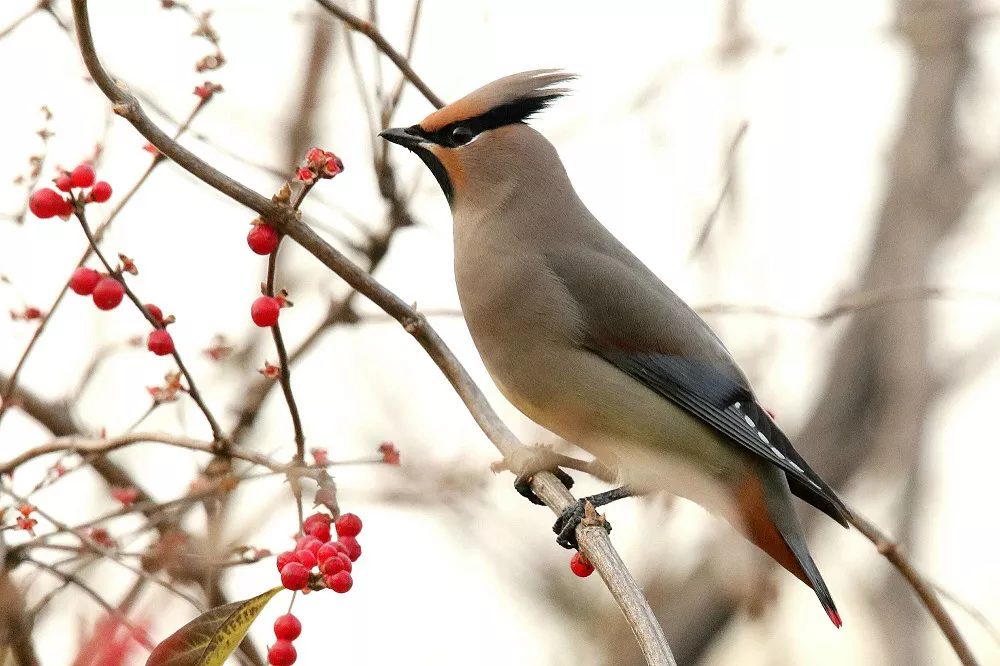The Bohemian Waxwing (Bombycilla garrulus) is a captivating bird species known for its stunning appearance and communal behavior. Found primarily in the northern regions of North America and Eurasia, the waxwings are highly adaptable and occupy a range of diverse habitats. In this article, we delve into the specific locations where Bohemian Waxwings live, shedding light on their habitat preferences and distribution.
Boreal Forests:
Bohemian Waxwings are strongly associated with boreal forests, which serve as their primary breeding habitats. These forests, characterized by dense stands of coniferous trees, provide an ideal environment for the waxwings. Here are key features of their boreal forest habitats:
North America: In North America, the waxwings breed in the vast boreal forests of Alaska and Canada. They are commonly found in regions such as Alaska’s interior, the Yukon, Northwest Territories, British Columbia, Alberta, and parts of Saskatchewan, Manitoba, Ontario, Quebec, and the Atlantic provinces.
Eurasia: Across Eurasia, Bohemian Waxwings occupy the boreal forests of northern Europe and Asia. Countries such as Sweden, Finland, Norway, Russia, and Mongolia serve as important breeding grounds for these birds.
Deciduous Forests:
While their breeding grounds are primarily boreal forests, Bohemian Waxwings are known to venture into deciduous forests during migration and wintering periods. These habitats offer an abundant food supply, consisting of berries and fruits. Some key aspects of their association with deciduous forests include:
Winter Range: During the winter months, Bohemian Waxwings undertake migratory movements in search of food. In North America, they can be found in regions such as the Rocky Mountains, the Pacific Northwest, and the Great Lakes area. They are also known to visit orchards and urban areas where berry-producing trees are plentiful.
Europe and Asia: In Eurasia, the waxwings winter in various countries, including Sweden, Finland, Russia, and Mongolia. They can be observed in woodland areas where there is an abundance of fruit-bearing trees.
Riparian Zones:
Bohemian Waxwings also utilize riparian zones during their breeding and migration periods. These areas, characterized by rivers, streams, and wetlands, provide critical resources for nesting and foraging. Key features of their association with riparian zones include:
Nesting: Riparian zones with dense vegetation along water bodies offer suitable nesting sites for the waxwings. They build cup-shaped nests in shrubs and trees, often near water sources, where they raise their young.
Foraging: Riparian habitats provide a diverse range of insect and berry resources, which form an essential part of the waxwings’ diet. Insects are particularly important during the breeding season when they are a crucial food source for the growing nestlings.
Urban and Suburban Areas:
Bohemian Waxwings have also adapted to urban and suburban environments, especially during winter when food sources are scarce. They are known to visit parks, gardens, and residential areas where berry-producing trees and shrubs are present. These adaptable birds demonstrate a willingness to exploit resources even in human-altered landscapes.
Range of Bohemian Waxwings
Bohemian waxwings have a circumpolar distribution, which means they are found in the northern latitudes all around the world. Their breeding range extends from Alaska across Canada to northern Europe and Russia. During their non-breeding season, Bohemian waxwings migrate southward to more temperate regions, such as the northern United States, Japan, and China.
Migration Patterns of Bohemian Waxwings
Bohemian waxwings are migratory birds, and their migration patterns are determined by the availability of food. In general, they migrate southward during the fall and winter months, and return northward during the spring and summer months.
Their migration patterns are not always predictable, as they may follow different routes or stopover locations depending on the availability of food. For example, if food is scarce in one area, they may move to another location where food is more abundant.
Interesting Facts About Bohemian Waxwings
Bohemian waxwings are fascinating birds with many interesting characteristics. Here are some fun facts about these beautiful birds:
They get their name from their Bohemian origins. Although they are found all over the world, their name comes from the region of Bohemia (now part of the Czech Republic), where John James Audubon first observed them.
They have a distinctive call. Bohemian waxwings have a high-pitched trilled call that sounds like “zeee.” Their calls can often be heard when they are flying overhead in flocks.
They are highly social birds. Bohemian waxwings are known for their flocking behavior, which can include hundreds or even thousands of individuals. They use their large flocks to find food, roost, and protect themselves from predators.
They have a varied diet. Bohemian waxwings are primarily fruit-eating birds, but they also eat insects, flower nectar, and even sap from trees.
They are beautiful birds. Bohemian waxwings are known for their striking appearance, with their red-tipped wings, black mask, and yellow-tipped tail feathers. They are truly one of the most beautiful birds in the world.
Conservation:
Protecting the habitats where Bohemian Waxwings reside is vital for their long-term survival. Conservation efforts should focus on preserving the integrity of boreal forests, maintaining riparian zones, and promoting the planting of native fruit-bearing trees in urban and suburban areas. These measures will ensure the availability of suitable nesting sites and a sustainable food supply for these enchanting birds.
Conclusion:
Bohemian Waxwings can be found in a range of habitats, with a strong association with boreal forests during the breeding season and a broader utilization of deciduous forests, riparian zones, and even urban areas during migration and winter. Understanding their habitat preferences and distribution allows us to appreciate their adaptability and underscores the importance of conserving these diverse habitats to support healthy populations of Bohemian Waxwings for future generations to enjoy.
Related topics:
- What is a Bohemian Waxwing?
- What do Bohemian Waxwings eat?
- Cedar Waxwing vs Bohemian Waxwing: What’s the Difference?


 Facebook
Facebook  Instagram
Instagram  Youtube
Youtube 